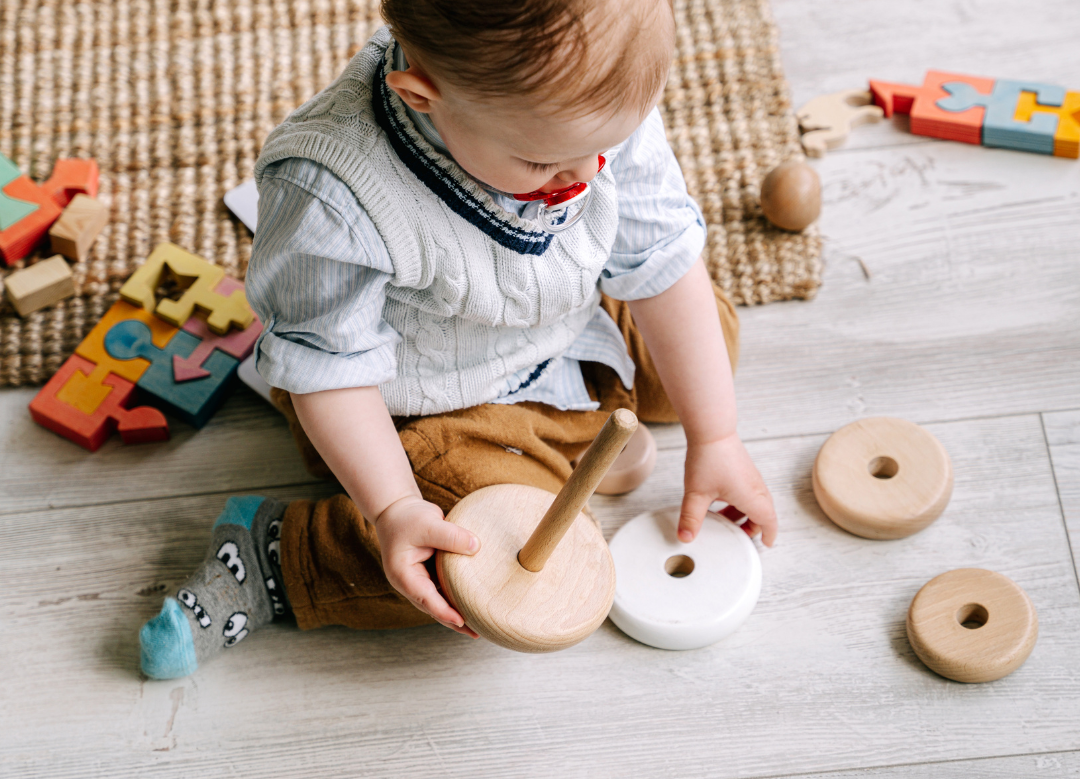Welcome to the Restful Baby Blog, a trusted resource for parents seeking guidance on their child's sleep journey. As a dedicated mother and pediatric sleep consultant, I understand how challenging sleep struggles can be. This blog offers expert advice, practical tips, and effective solutions to help your little one (and your family) get the restful, restorative sleep you all need. Whether you're navigating newborn sleep patterns or dealing with toddler bedtime battles, my mission is to empower parents with the tools and knowledge to create healthy sleep habits that last a lifetime.

The Best Bedtime Routines for Working Parents As a working parent, your day doesn’t slow down when the workday ends—it shifts gears. Between dinner prep, school paperwork, and bedtime battles, the evening can feel more like a sprint than a wind-down. But here’s the good news: a consistent, calm bedtime routine doesn’t have to take an hour (or your last shred of energy). In fact, with a few intentional steps, you can create a sleep-friendly routine that works for your child—and your schedule. Here’s how to build the best bedtime routine for working parents who want peaceful evenings and well-rested kids. 1. Start with Connection, Not Control After a long day apart, your child craves connection. Before diving into “get ready for bed” mode, spend just 5–10 minutes doing something calm and connecting: Cuddle on the couch Read a short book together Do a quiet puzzle or coloring page This small moment of presence helps fill your child’s emotional tank, making them more cooperative during the routine that follows. 2. Keep It Short and Predictable (20–30 Minutes Total) A good bedtime routine doesn't need to be long or elaborate. The key is consistency. Choose a 3–5 step routine you can repeat every night. For example: Sample 20-Minute Bedtime Routine: Bath or quick wash-up Pajamas and teeth brushing Book (or two!) Hugs/kisses and a short chat Lights out with a soothing sound machine or nightlight Tip: Start the routine at the same time each night. Children thrive on predictability—it helps their body and brain prepare for sleep. 3. Use Visuals and Routines Charts If your child resists bedtime transitions, a visual bedtime chart can be a game changer. Simple pictures of each step (e.g., pajamas, book, bed) can make the routine feel more like a game than a struggle—and it keeps you from having to nag or repeat yourself. Bonus: Let your child check off each step. It gives them a sense of control in a predictable framework. 4. Set Boundaries with Love Working parents often feel guilty about limited time with their kids, and bedtime can become a stalling ground for "just one more..." requests. The best way to handle this? Set clear boundaries with warmth. Try: “We have time for two books tonight. I can’t wait to read them with you!” Or: “After our story, I’ll tuck you in and check on you in 10 minutes.” Being firm and kind shows your child that bedtime is safe, predictable, and non-negotiable. 5. Lean on Tools, Not Screens Avoid screen time at least an hour before bed—it interferes with melatonin production. Instead, use calming tools: A white noise machine or calming playlist A diffuser with lavender essential oil (safe for kids over 6 months) A special bedtime-only stuffed animal or blanket These sensory cues help signal to your child’s brain: “It’s time for sleep.” 6. Be Kind to Yourself, Too Even with the perfect routine, some nights will go off the rails. That’s okay. Working parents wear a lot of hats—employee, parent, chef, chauffeur, bedtime storyteller. You don’t have to be perfect to raise a well-rested child. If bedtime is consistently a struggle or if your child has ongoing sleep difficulties, you're not alone—and you're not failing. This is where professional sleep support can make all the difference. Final Thoughts A solid bedtime routine is one of the most powerful tools a working parent can use to support their child’s sleep. And when your child sleeps better, you sleep better—which makes everything else more manageable. If you’re ready to bring calm to your evenings and want support tailoring a routine for your unique family, I’m here to help.

Back-to-School Sleep Routines: How to Help Your Child Transition Smoothly As summer winds down and the school year approaches, many families find themselves grappling with one tricky challenge: getting kids back on a healthy sleep schedule. Long summer evenings, travel, camps, and relaxed routines often mean later bedtimes and sleep-ins. But now it’s time to get back on track—because well-rested kids are better learners, better behaved, and better equipped to handle the demands of the school day. As a pediatric sleep consultant, I work with many families during this transition. The good news? With a little planning and patience, it’s completely possible to reset your child’s sleep habits and start the school year strong. Why Sleep Matters for School-Aged Children Children between the ages of 6 and 12 typically need 9–12 hours of sleep per night , according to the American Academy of Sleep Medicine. Adequate sleep helps with: Memory and learning Emotional regulation Attention and focus Immune health Physical growth When children don’t get enough sleep, it can show up as moodiness, hyperactivity, poor academic performance, and increased susceptibility to illness. 1. Start the Transition Early Ideally, begin adjusting your child’s sleep schedule 1–2 weeks before school starts . Gradually shift bedtime earlier by 15–30 minutes every few nights , and do the same with wake-up times. This slow change allows your child’s internal clock (circadian rhythm) to reset more naturally. If school is just a few days away, don’t panic. Start now, and focus on consistency—even a few days of structured routine can make a difference. 2. Set a Consistent Bedtime and Wake Time Children thrive on routine. Try to keep bedtimes and wake times consistent—even on weekends . While a little flexibility is okay, large variations can disrupt their body clock and make weekday mornings harder. 3. Create a Calming Evening Routine A predictable, relaxing bedtime routine helps signal to your child’s brain that it’s time to wind down. This can include: A warm bath or shower Brushing teeth Reading a book or quiet storytelling Gentle music or white noise Dimmed lights and no screens Avoid stimulating activities (video games, roughhousing) at least an hour before bed. 4. Limit Screen Time in the Evenings The blue light from tablets, TVs, and phones can interfere with melatonin production, making it harder for kids to fall asleep. Aim to power down all screens at least 60 minutes before bedtime . 5. Optimize the Sleep Environment Make sure your child’s bedroom is: Cool (between 65–70°F) Dark (use blackout curtains if needed) Quiet (or use white noise if helpful) Comfortable (invest in a cozy mattress and bedding) Remove distractions like TVs and tablets from the bedroom if possible. 6. Be Patient and Consistent Adjusting to a new routine takes time, especially after a carefree summer. Some kids adapt quickly, while others may take a couple of weeks. The key is consistency . Stick to the new routine even if it feels tough at first. Your child’s body will adjust, and better sleep will follow. Final Thoughts Back-to-school season can feel hectic, but it’s also a great opportunity to reset your family’s routines. Supporting your child’s sleep now sets the stage for a smoother, healthier school year. If your child struggles with falling asleep, staying asleep, or resisting bedtime even with a consistent routine, it may be helpful to speak with a pediatric sleep consultant for personalized guidance. Here’s to a well-rested start to the school year!

Sleep Training Without Guilt: Navigating the Emotional Side of Sleep Coaching A compassionate guide for tired parents facing pressure, shame, or online judgment As a pediatric sleep consultant, I’ve seen firsthand how deeply emotional the decision to sleep train can be. Parents come to me exhausted, desperate for rest — yet also burdened with guilt. They’ve read the forums. They’ve been sent the unsolicited articles. Sometimes, they’ve even been told they're harming their child by simply trying to get a full night’s sleep. Let’s be clear: wanting your child (and yourself) to sleep is not selfish. It’s not harmful. It’s human. And most importantly — it’s okay. The Shame Spiral: Where Does It Come From? There’s a lot of pressure on modern parents to do everything “perfectly.” Add in social media, parenting influencers, and endless advice, and suddenly sleep training becomes a moral debate instead of a personal decision. Common guilt-inducing messages parents hear: “If your baby cries, they’ll think you’ve abandoned them.” “Your baby will sleep when they’re ready — you just need to be more patient.” “You chose to have kids — losing sleep is part of the deal.” These statements are often well-meaning, but they’re not always rooted in science — and they certainly don’t take your unique child, circumstances, or mental health into account. What the Research Actually Says Modern, evidence-based sleep training methods — including gentle and responsive approaches — have been studied extensively. When done thoughtfully and with love, they do not harm a child’s emotional development or attachment to their caregiver. In fact, many families report that once sleep improves: Bonding feels easier. Parents are more present and less reactive. Children are more content during the day. Well-rested families function better. That’s not guilt-worthy. That’s essential. Sleep Training ≠ Abandonment One of the biggest misconceptions is that sleep training equals “crying it out” and leaving your baby alone, afraid, and ignored. That’s not the only way — and it's not the method most professionals recommend. Sleep coaching can be: Gradual Responsive Comforting Aligned with your values It’s not about ignoring your baby’s needs. It’s about helping them develop a skill — the ability to fall asleep independently — with your loving support. You Don’t Owe the Internet an Explanation One of the hardest parts of parenting today is doing it under a microscope. You post about sleep training, and suddenly everyone has an opinion. Even if you keep it private, the fear of judgment can creep in. Here’s the truth: You don’t have to justify your decisions to strangers on the internet. You are the expert on your child. You get to choose what works best for your family. Give Yourself Permission If you’re thinking about sleep training, or already doing it, and feeling guilty — take a deep breath. Then try this reminder: “I’m a good parent, doing my best. Supporting my child’s sleep is an act of love — not neglect.” You’re allowed to want rest. You’re allowed to set boundaries. You’re allowed to feel confident in your parenting, even when others disagree. You’re Not Alone Whether you're in the thick of sleep training or just exploring your options, know this: you're not doing it wrong just because someone else wouldn’t do it your way. If you need guidance, support, or just a non-judgmental ear — that’s what I’m here for. My blog is a safe, shame-free space for tired parents looking for real solutions and a little more peace.

Safe Sleep 101: A Complete Guide to Reducing SIDS Risk As a parent, nothing is more important than keeping your baby safe — especially while they sleep. Sudden Infant Death Syndrome (SIDS) is one of the most heartbreaking and misunderstood risks during infancy. The good news? While SIDS can’t always be explained, there are clear, research-backed steps we can take to reduce the risk and create a safe sleep environment for your little one. In this guide, I’ll walk you through the most up-to-date safe sleep recommendations so you can feel confident putting your baby to bed. What is SIDS? SIDS, or Sudden Infant Death Syndrome, refers to the sudden and unexplained death of an otherwise healthy baby, typically during sleep and most commonly between 1–4 months of age. While it’s scary to think about, it’s important to remember that education and prevention go a long way . The ABCs of Safe Sleep The American Academy of Pediatrics (AAP) uses a simple acronym to help parents remember the basics: A — Alone : Your baby should always sleep alone in their own sleep space (bassinet, crib, or play yard). No pillows, stuffed animals, blankets, or bumper pads. B — Back : Always place your baby on their back to sleep — for naps and nighttime. C — Crib : Use a flat, firm mattress in a safety-approved crib or bassinet. 💡 Tip : Once your baby can roll both ways, it’s okay to let them stay in the position they choose, but always start sleep on their back. Top Safe Sleep Guidelines (Backed by Science) ✅ Use a Firm Sleep Surface Your crib mattress should be firm and fit snugly into the crib. Avoid soft bedding, memory foam, or inclined sleepers. ✅ Keep the Crib Bare Skip crib bumpers, quilts, stuffed animals, and extra padding. A tight-fitting crib sheet is all you need. ✅ Room Share, Don’t Bed Share It’s safest for baby to sleep in the same room, but not the same bed , for at least the first 6–12 months. ✅ Avoid Overheating Dress your baby in light sleep clothing (like a sleep sack) and keep the room temperature comfortable — not too hot. Overheating is a risk factor for SIDS. ✅ Offer a Pacifier at Sleep Time If breastfeeding is well established, offering a pacifier at naps and bedtime may reduce the risk of SIDS. ✅ No Smoking Around Baby Smoking during pregnancy and exposure to secondhand smoke increases the risk of SIDS. Create a smoke-free environment. Safe Sleep Myths (and What You Need to Know) Myth: My baby won’t sleep unless they’re on their tummy. Truth: It might take some adjusting, but all babies can learn to sleep on their back safely. Tummy sleeping raises the risk of SIDS significantly in young infants. Myth: A little blanket will keep my baby cozy. Truth: Instead of loose blankets, use a wearable blanket or sleep sack designed for infants. Myth: Crib bumpers prevent injury. Truth: They actually pose a risk of suffocation and are no longer recommended. Safe Sleep Checklist for Every Nap and Night Baby is on their back Sleeping in a crib, bassinet, or play yard No loose items in sleep space Dressed appropriately for room temperature Pacifier offered if baby will take it Non-smoking environment Final Thoughts Safe sleep isn’t about perfection — it’s about consistency and awareness. These small, mindful choices can have a big impact on your baby’s safety and sleep quality. As a pediatric sleep consultant, I’m here to help you create a sleep environment that is safe, nurturing, and effective. If you ever feel overwhelmed or unsure, reach out. You're not alone in this.

How to Transition from Co-Sleeping to Independent Sleep: A Step-by-Step Guide Transitioning your child from co-sleeping to independent sleep can be a challenging, yet incredibly rewarding experience for both you and your little one. Whether you’ve been co-sleeping by choice or necessity, it’s natural for parents to want their child to eventually sleep in their own space. The good news is that with a little patience, consistency, and the right approach, you can help your child embrace independent sleep and create a healthier sleep environment for everyone. Here’s a step-by-step guide to make this transition smoother for both you and your child: 1. Set the Stage with Positive Sleep Associations Before beginning the transition, it’s helpful to create positive sleep associations. This means associating sleep with calm, soothing experiences that your child can look forward to. Create a calming bedtime routine : A consistent bedtime routine is key in preparing your child for sleep. Whether it’s a bath, reading a book, or singing a lullaby, the routine should be calm and predictable. Make the environment sleep-friendly : Dim the lights, reduce noise, and keep the room at a comfortable temperature. You can also use a white noise machine to block out distractions and create a peaceful sleep environment. 2. Start with Gradual Separation One of the most effective ways to help your child transition from co-sleeping to independent sleep is through gradual separation. This method involves slowly reducing your presence in the room until your child is comfortable falling asleep on their own. Step-by-step approach : If you currently sleep in the same bed, start by placing your child in their crib or bed while you sit next to them. Over the course of several nights, gradually move further away from the bed, eventually leaving the room entirely as they fall asleep. Comfort and reassurance : It’s important to provide comfort and reassurance during this transition. You can gently pat your child, offer soothing words, or even stay in the room for a few minutes until they feel safe. 3. Be Consistent with Sleep Time Consistency is crucial when transitioning to independent sleep. Establishing a consistent bedtime and wake-up time helps regulate your child’s internal clock, making it easier for them to fall asleep and stay asleep on their own. Same time every night : Set a consistent bedtime and stick to it, even on weekends. This consistency will help your child’s body adjust to the new sleep routine. Stick to the plan : If you’re using a gradual separation method or another technique, be patient and consistent in applying it. Sudden changes or inconsistency can confuse your child and make the transition harder. 4. Offer Comfort Objects Many children find comfort in having a special object, like a blanket or a stuffed animal, to help them feel secure at bedtime. Introduce a lovey : If your child doesn’t already have one, consider introducing a soft toy or blanket that they can associate with sleep. This object can provide comfort and help them feel safe when falling asleep alone. Use a transitional object : If your child is hesitant to sleep alone, a transitional object such as a t-shirt with your scent or a special pillow can help them feel connected to you during the transition. 5. Celebrate Small Wins This process can take time, and it’s important to celebrate every small success. Praise your child for each step they take toward independent sleep, whether it’s staying in their own bed for a few minutes or falling asleep without you in the room. Positive reinforcement : Offer words of encouragement, such as “You did great!” or “I’m so proud of you for sleeping in your own bed tonight.” Reward system : Consider using a sticker chart or other positive reinforcement to motivate your child and give them a sense of accomplishment. 6. Stay Calm and Be Patient It’s normal for both you and your child to feel some anxiety during the transition. Your child may resist, cry, or even wake up during the night, and that’s okay. Patience is key to this process. Offer comfort, not a return to co-sleeping : If your child wakes up in the middle of the night and is upset, offer reassurance, but avoid bringing them back to your bed. Gently guide them back to their own bed and reassure them they are safe. Expect setbacks : It’s common for children to experience some setbacks along the way. If your child regresses or has a tough night, don’t get discouraged. Keep moving forward with consistency, and they will adjust in time. 7. Know When to Seek Help If you’ve tried various techniques and the transition is still very difficult, it might be helpful to consult a pediatric sleep consultant. They can offer tailored guidance and strategies to help your child make the leap to independent sleep in a way that feels comfortable for your family. Final Thoughts: Embrace the Process Transitioning from co-sleeping to independent sleep is a big milestone, and every child will approach it differently. Remember, the process takes time, so be patient with both yourself and your little one. With a consistent approach, lots of love, and reassurance, your child will learn to sleep independently, giving them a strong foundation for healthy sleep habits as they grow. If you’re feeling uncertain or need more personalized support, feel free to reach out to a pediatric sleep consultant who can guide you through the process. You don’t have to do it alone!

Dealing with Early Morning Wake-Ups Early morning wake-ups are a common challenge for many parents, and they can leave both you and your little one feeling groggy and irritable. While it’s normal for babies to wake up during the night or early in the morning, a baby who regularly wakes up before 6 a.m. can quickly throw off your family’s entire sleep routine. If you’re struggling with your infant waking up too early, you’re not alone. Fortunately, there are several strategies you can try to help your baby sleep a bit longer and wake up at a more reasonable hour. Here’s a guide on how to manage those early morning wake-ups and help your infant sleep soundly for longer: 1. Understand Your Baby’s Sleep Needs The first step in tackling early morning wake-ups is understanding your infant’s specific sleep needs. Infants go through different sleep cycles, and their sleep patterns evolve as they grow. Newborns (0-2 months) : Newborns need around 14-17 hours of sleep a day, often in shorter stretches. Infants (3-6 months) : By this stage, babies may sleep 12-15 hours, with longer stretches at night and shorter naps during the day. Older infants (6+ months) : At this age, your baby may start to consolidate sleep into longer nighttime stretches, typically sleeping 11-12 hours at night, with a couple of daytime naps. If your baby’s early morning wake-ups seem to be linked to a lack of sufficient nighttime sleep, you may need to adjust their bedtime or nap schedule to ensure they’re getting enough rest. 2. Set a Consistent Bedtime One of the most common causes of early morning wake-ups is an inconsistent or too-late bedtime. When babies are overtired, they may fall asleep quickly but wake up earlier than usual due to disrupted sleep cycles. Establish a bedtime routine : A calming bedtime routine that happens around the same time every night can help signal to your baby that it’s time to sleep. This may include a bath, a feeding, or reading a short book. Aim for an appropriate bedtime : For most infants, a bedtime between 6:30 and 8 p.m. is ideal. If your baby is going to bed too late, they might be overtired and more prone to waking up early in the morning. By keeping a consistent bedtime, you’ll help your baby fall into a regular sleep pattern, which can help prevent early morning wake-ups. 3. Create a Dark, Quiet Sleep Environment Light and noise can be significant factors in early morning wake-ups. As the sun rises, the increasing light can naturally signal to your baby that it’s time to wake up. Blackout curtains : Installing blackout curtains in your baby’s room can help block out early morning light and keep the room darker for longer. White noise : White noise can help mask sounds from outside or other areas of the house that might disturb your baby’s sleep. Consider using a white noise machine or a fan to create a consistent sound that helps your baby stay asleep. A quiet, dark environment is essential for promoting longer, more restful sleep for your infant, even in the early morning hours. 4. Wait Before Going to Your Baby It’s tempting to rush into your baby’s room at the first sign of waking, especially if it’s early in the morning. However, it’s important to give your baby a few minutes to settle on their own. Babies can sometimes stir during their sleep cycles and may cry or fuss briefly before falling back asleep. Wait 5-10 minutes : If your baby wakes up early, try to wait a few minutes before going in. They may settle themselves back to sleep without your intervention. Check for hunger or discomfort : If your baby continues to cry after a few minutes, check to see if they’re hungry, uncomfortable, or need a diaper change. If not, gently reassure them by patting their back or using soothing words before leaving the room again. This waiting approach can teach your baby to self-soothe and may help them transition back to sleep without relying on you to intervene every time they wake up. 5. Adjust Nap Times and Wake Windows If your baby is taking long naps late in the afternoon or early evening, this could contribute to early morning wake-ups. Adjusting your baby’s nap schedule may help ensure they are not over- or under-tired at bedtime. Earlier nap times : Try to schedule naps earlier in the day to avoid late-afternoon naps that could interfere with nighttime sleep. Monitor wake windows : Pay attention to your baby’s wake windows—the amount of time they can comfortably stay awake between naps. Overestimating how long they can stay awake before their next nap may lead to them becoming overtired, which can lead to early morning waking. By fine-tuning nap times and wake windows, you can help prevent your baby from being too overtired or too rested when bedtime arrives. 6. Avoid Overstimulation Before Bedtime Overstimulation in the evening can make it harder for your baby to fall asleep and stay asleep through the night. Avoid activities that are too stimulating or exciting before bedtime. Limit screen time : If you’re using screens (like phones or TVs) before your baby’s bedtime, keep it to a minimum. Bright lights and screens can affect the production of the sleep hormone melatonin. Keep things calm : Instead of active play, opt for calming activities like reading a book, singing a lullaby, or gentle rocking. Creating a calm, soothing environment before bed will help your baby wind down and make it easier for them to stay asleep through the night—and possibly sleep a little later in the morning. 7. Consider the 4-Month Sleep Regression If your infant is around 4 months old, you may be experiencing the infamous "sleep regression." During this time, babies’ sleep patterns change, and they may wake up more frequently during the night or in the early morning. This phase can last anywhere from a few weeks to a few months. Be patient : If your baby is going through a sleep regression, be patient as they adjust to the new sleep patterns. It’s temporary, and things should improve as they continue to develop. Stick to the basics : Continue following a consistent bedtime routine, maintaining a calm sleep environment, and offering comfort when needed. 8. Stay Consistent One of the most important things you can do when dealing with early morning wake-ups is to stay consistent with your approach. Whether you’re using a gradual sleep training method or simply adjusting your baby’s bedtime and nap schedule, consistency will help your baby learn what to expect and help them adjust over time. Final Thoughts: Patience and Persistence Pay Off Dealing with early morning wake-ups can be exhausting and frustrating, but with patience and the right strategies, you can help your infant develop healthier sleep habits. By establishing a consistent bedtime routine, creating an optimal sleep environment, and being mindful of their sleep needs, you’ll give your baby the best chance for longer, more restful sleep. Remember, every baby is different, and it may take some time for your little one to adjust. If you find that early morning wake-ups continue despite your efforts, it might be worth reaching out to a pediatric sleep consultant for personalized support.

Tips for Nap Time Success: Helping Toddlers and Infants Sleep Better During the Day Naps are an essential part of a child’s development, offering them the rest they need to recharge and support their growing brains and bodies. However, getting toddlers and infants to sleep soundly during the day can sometimes be a challenge. Whether you’re dealing with nap resistance, irregular nap times, or short naps, it’s important to create a consistent routine and environment that encourages quality daytime sleep. Here are some tips for ensuring nap time success for both toddlers and infants: 1. Set a Consistent Nap Schedule Children thrive on routine, and having a consistent nap schedule is key to helping your little one get the rest they need. A predictable nap routine allows their body clock to sync up, making it easier for them to fall asleep and stay asleep during the day. Create a regular nap window : Try to offer naps at the same time each day. For infants, this could be after their morning feed and again in the afternoon. For toddlers, aim for two naps a day or one longer afternoon nap, depending on their age and sleep needs. Watch for sleep cues : Infants and toddlers will show signs of tiredness—rubbing eyes, yawning, or becoming fussy. Try to catch these cues early and begin the nap routine before your child becomes overtired, which can make it harder for them to fall asleep. 2. Make the Nap Environment Calm and Comfortable The environment where your child naps plays a big role in whether they’ll settle down for a restful nap. Creating a sleep-friendly environment is especially important for both infants and toddlers. Dim the lights : Keep the room dark or use blackout curtains to minimize distractions and promote a calm atmosphere. Light can interfere with melatonin production, which is essential for sleep. Keep noise to a minimum : Quiet surroundings are ideal for nap time, but a white noise machine can help drown out any background noise and keep the environment soothing. Comfortable temperature : Ensure the room is at a comfortable temperature—ideally between 68–72°F (20–22°C). Too hot or too cold can make it difficult for your child to fall and stay asleep. 3. Keep Nap Time Routines Simple and Predictable Just like a bedtime routine, a simple and predictable nap time routine can signal to your child that it’s time to sleep. Infants and toddlers alike benefit from having a calm, structured routine before naps. Soothing pre-nap activities : Whether it’s a short book, soft music, or cuddling, keep the pre-nap routine consistent so your child knows what to expect. Avoid stimulating activities : Steer clear of exciting or energetic play before nap time. Instead, focus on calming activities like reading, gentle rocking, or soft singing. 4. Be Mindful of Wake Windows Infants and toddlers both have optimal wake windows—periods of time when they are most ready for a nap. If you wait too long, your child may become overtired, making it harder for them to fall asleep. If you nap too soon, they might not be tired enough to settle. Infant wake windows : Newborns may only stay awake for 45 minutes to an hour, while older infants (6-12 months) can manage 2-3 hours of wakefulness between naps. Toddler wake windows : Toddlers can typically stay awake for 4-6 hours before needing a nap. Adjust nap times based on your child’s individual needs and developmental stage. 5. Limit Naps to the Right Duration While naps are crucial for your child’s well-being, naps that are too long or too late in the day can interfere with their nighttime sleep. Finding the right balance for your child’s nap duration is key. Infants : Newborns sleep a lot, but as they grow, they tend to take two to three naps per day. Aim for around 3-4 hours of nap time total. As they near 6 months, this may decrease to 2-3 naps. Toddlers : By age 2 or 3, many toddlers switch to one longer nap in the afternoon, typically lasting 1.5 to 2 hours. Avoid naps later than 3:30 PM to ensure bedtime isn’t delayed. 6. Stay Calm and Be Patient Not every nap will be perfect, and that’s okay! Some days, your child may resist naps or take shorter naps than usual. The key is to stay calm and patient during the process. Don’t stress if naps are short : If your child only takes a short nap, don’t worry too much—sometimes, it’s just a phase. You can try offering a second nap or adjusting the schedule if necessary. Avoid rushing in when they cry : If your child fusses a bit after being placed in their crib, give them a few moments to self-soothe. It can take time for some children to settle down on their own. 7. Be Flexible As your child grows and develops, their nap needs will change. Infants may outgrow a nap stage, and toddlers may eventually drop to a single nap during the day. Be flexible with your routine and adjust based on your child’s needs and development. Developmental changes : Keep in mind that milestones, teething, or illness can affect nap times temporarily. If your child suddenly resists naps, it might be due to an underlying change or developmental phase. Gradual adjustments : If you need to shift nap times or durations, do so gradually. Small adjustments can make a big difference in helping your child maintain a restful nap schedule. 8. Avoid Overstimulation Before or After Naps Both infants and toddlers are more likely to nap well if their activity levels are balanced. Avoid overstimulating your child immediately before or after naps, as this can interfere with their ability to fall asleep or stay asleep. After naps : Greet your child warmly after their nap and keep the transition from nap to awake time low-key. Too much excitement can disrupt the calm they need after waking. Final Thoughts: Nap Time Success for a Happy, Healthy Child Naps are an essential part of your child’s day, providing the rest and rejuvenation they need for proper growth and development. By creating a consistent routine, providing a peaceful nap environment, and being patient with the process, you can set your toddler or infant up for nap time success. If you’re struggling with nap resistance or your child’s sleep patterns seem out of sync, don’t hesitate to reach out for personalized sleep support. Every child’s sleep needs are different, and with the right strategies, you can help them establish healthy, restorative nap habits.

How to Support Your Baby During Daylight Savings Time Daylight savings time can be a challenging transition for parents, especially when it comes to babies and young children. The shift in time—whether you're “springing forward” or “falling back”—can disrupt your little one’s sleep schedule, leaving both baby and parents feeling a little out of sync. But don’t worry! With a little preparation and patience, you can make the transition smoother for everyone. Here are some practical tips to help your baby adjust to the time change: 1. Gradually Adjust Your Baby’s Schedule If you know that daylight savings time is coming up, try making gradual adjustments to your baby’s sleep schedule a few days before the time change. For Spring Forward (Losing an Hour): Begin by moving your baby’s bedtime 10-15 minutes earlier each day for a few days before the time change. This way, by the time the clocks change, your baby will already be closer to the new bedtime. For Fall Back (Gaining an Hour): You can take the same approach by moving your baby’s bedtime 10-15 minutes later each day. This will help your baby ease into the extra hour of sleep without disrupting their routine too much. 2. Adjust Wake Time Gradually Along with bedtime, you’ll also want to adjust your baby’s wake time. This is especially important if your baby has a strict morning routine. Gradually shifting your baby’s wake-up time by 10-15 minutes in the days leading up to the time change will help ease the transition. 3. Be Consistent with Naps If your baby still takes naps during the day, try adjusting nap times slowly. Keep the same general interval between naps (e.g., if your baby naps 2 hours after waking, continue that rhythm but shift by the same 10-15 minute increments). Consistency in nap times can help your baby feel more settled during this change and prevent them from becoming overtired. 4. Keep the Bedtime Routine Familiar Babies thrive on consistency, and keeping your bedtime routine the same—whether it’s a bath, a lullaby, or a favorite stuffed animal—can help signal to your baby that it’s time to wind down, even if the clock has changed. Avoid skipping steps, even if it feels like they need to go to sleep earlier or later than usual. This familiar routine will help your baby feel secure and ready for rest. 5. Manage Daylight Exposure Light plays a big role in regulating your baby’s internal clock. After the time change, it’s important to expose your baby to natural light during the day, especially in the morning, to help them adjust to the new time. If you can, take your baby outside for a walk in the morning sunlight. The exposure to natural light will help reset their circadian rhythm and make the transition easier. At night, keep the lighting dim and calming during the bedtime routine. This will signal to your baby’s brain that it’s time to sleep, even if the clock has changed. 6. Be Patient It’s normal for the transition to take a few days, so try not to stress if your baby seems a little more fussy or has trouble adjusting. Every baby is different, and some might adapt quicker than others. Stick with your gradual adjustments, keep the routine steady, and your baby should eventually settle into the new sleep schedule. 7. Create a Sleep-Friendly Environment Ensure that your baby’s sleep environment is as conducive to sleep as possible. Keep the room dark (using blackout curtains, if needed), cool, and quiet. A white noise machine can also be helpful to mask any disruptive sounds, especially if you’re dealing with different lighting or external noise during the transition. 8. Be Flexible with Feedings If your baby is still nursing or formula feeding, you may also want to adjust their feeding times gradually in the days leading up to the time change. This way, you can help avoid hunger disruptions at bedtime or during the night. 9. Stick to Healthy Sleep Habits Even with the daylight savings time change, it’s important to stay consistent with healthy sleep habits for your baby. If your little one is used to falling asleep independently (without rocking or nursing to sleep), try to maintain that routine. Babies who are used to being put down drowsy but awake will typically have an easier time adjusting to new sleep schedules, as they already know how to self-soothe and fall asleep on their own. 10. Don’t Forget About You! The daylight savings time change can be tough on parents, too. If you’re feeling exhausted from adjusting your baby’s schedule, take a deep breath and remember that this transition is temporary. Make sure to give yourself time to rest and recharge as well—whether that means getting extra sleep, taking turns with your partner, or asking for help when needed. Final Thoughts Daylight savings time may be an unavoidable event, but with these tips, you can minimize its impact on your baby’s sleep schedule and make the transition as smooth as possible. Remember, the key is to be gradual, consistent, and patient as your little one adjusts to the new time. If you're struggling with sleep transitions or your baby’s sleep patterns, don’t hesitate to reach out for professional support. As a pediatric sleep consultant, I’m here to help you navigate these changes and create a sleep plan tailored to your family’s needs.

After sleep-training your child, it’s common to experience setbacks at some point so it’s important to understand what’s happening and what kind of adjustments you can make to get your child back on track. In this blog post I’m going to talk about my recent experience with our 18-month-old toddler. We’ll talk about some of the bedtime struggles we started having over the holidays and what we did to correct them. I’m going to give you step-by-step direction on what I did to improve his schedule and how we encouraged him to start sleeping through the night again. In my opinion, 18-months is the most challenging time to correct bedtime struggles. The reason for this is because they are big babies now, so they don’t mind protesting louder and longer. If this is the first time that they’ve been sleep trained, it can be challenging because they get used to their current habits and it takes more time to encourage new healthy routines. The crying can be hard, especially for the parents, so I do my best to avoid the tears as much as possible although you’ll see I just wasn’t able to avoid them all together here. My son was only a few months old when we chose to sleep train him. He responded well to sleep training and slept through the night most of the time, sometimes waking once for a feeding, but that was it. We were consistent and he continued to sleep well even while we made daytime nap transitions and worked through his separation anxiety. Our recent sleep struggles began over the holidays. We had a lot going on and we didn’t prioritize our routines as much as we usually do. We made choices that didn’t align with our current schedule, and we started bringing him into our bed for early morning snuggles. What came next was a series of sleep troubles. My baby suddenly started waking up at night wanting to be snuggled. He was waking multiple times a night and crying if he noticed us leaving the room before he fell asleep. Everyone falls off routine sometimes so it’s important to know what to do to get them back on routine and start encouraging independent sleep again. The first thing I always do is make sure I have my routines in line. Babies thrive when their routines are consistent and predictable, so that must be a priority. At 18 months of age my son needs one nap a day, not exceeding 3 hours, and we do a 7pm bedtime for him. When it’s time for bed we do our bedtime routines, hold him for a quick snuggle and then tuck him into his bed, we say goodnight and then leave the room while he's calm but still awake. There are many different methods that can be used when encouraging independent sleep. It’s important that you choose a method and have a plan for what to do when your baby starts crying. I always choose which method will work best based on the baby’s temperament and how the parent feels about crying. For my son, check-ins have been very effective in the past, so it was an easy choice for us. After we say goodnight and leave the room, he usually rubs his hair and falls asleep on his own. Since we’ve been off our routines, he started standing up in his crib and crying as soon as I leave the room. I chose to start check-ins in 4 or 5 minute intervals. When my timer goes off, I go into his room, give him a quick snuggle then lay him back down and rub his hair until he’s relaxed. When he is calm but still awake, I leave the room again. I continue to do check ins at 4 or 5 minute intervals until he falls asleep. The first two nights are always the hardest and take the most work, but progress is often seen by night 3. It wasn't long before he was sleeping through the night again! When it comes to check-ins, each situation is different so the time intervals should be left up to the parents and then check-ins need to be done every single time the timer goes off. Consistency is the key here. The goal is to teach your baby that you are always coming back and that they are safe in their space. After a few days of consistency, your baby will learn that you’ll be back, and they’ll learn to self soothe. Eventually the goal is to lay them down relaxed, be able to leave the room and they fall asleep on their own. Setbacks are common, they can happen due to teething, sleep regressions, or simply because we’ve fallen off routine. The best thing you can do it dial in your routines and stay consistent. Baby’s love consistency and predictability and a well rested baby is beneficial for the entire family. I have a separate blog post that has a lot of helpful information for creating the best environment to encourage sleep. Combining a comfortable sleep environment, consistent routine, and responding appropriately to crying, is the perfect combination to get your baby sleeping better in no time.

Sleep training is a term that often surfaces in parenting discussions, especially among those navigating the challenges of getting their little ones to sleep soundly through the night. What exactly is sleep training, and how does it work? In this guide, we'll talk about the fundamentals of sleep training, shedding light on its purpose and the mechanics behind this transformative process. What is Sleep Training? Sleep training is a set of strategies and techniques designed to help babies and young children develop healthy sleep habits. The ultimate goal is to teach them to fall asleep independently and stay asleep through the night. While it might sound like a dream for sleep-deprived parents, understanding the nuances of sleep training is crucial for success. Establishing a Consistent Routine Consistency is key in sleep training. Creating a bedtime routine signals to your child that it's time to wind down. This could include activities like reading a book, taking a warm bath, or listening to soothing music. Establishing a consistent routine helps set the stage for a restful night's sleep. Sleep training is a personal journey for each family, and there is no one-size-fits-all approach. Understanding your child's unique needs and temperament is essential in crafting a sleep training plan that works for both you and your little one. While it may take time and patience, the rewards of a good night's sleep for both parents and child are well worth the effort. Why Consider Sleep Training? 1. Promoting Healthy Sleep Habits Sleep is crucial for a child's development and well-being. Establishing healthy sleep habits early on can lead to improved mood, cognitive function, and overall health. Sleep training aims to instill these habits, setting the stage for a lifetime of restful sleep. 2. Encouraging Independence One of the primary goals of sleep training is to foster a sense of independence in children when it comes to falling asleep. Teaching them to self-soothe and settle into sleep without constant parental intervention can contribute to more seamless nights for both child and parent. 3. Enhancing Family Well-being The sleep patterns of a child often impact the entire family. Sleep-deprived parents may find themselves facing challenges in their daily lives. Sleep training is a proactive approach to improving the overall well-being of the family unit, promoting a more harmonious and balanced household. The Foundations of Sleep Training 1. Consistency is Key At the heart of sleep training lies the principle of consistency. Establishing a regular bedtime routine provides a comforting signal to your child that it's time to wind down. Consistency in approach and response helps create a sense of predictability, contributing to a smoother sleep transition. 2. Understanding Each Child's Individual Needs Every child is unique, and what works for one may not work for another. Successful sleep training involves recognizing and understanding your child's individual needs, temperament, and cues. Tailoring your approach accordingly fosters a more effective and compassionate sleep training experience. Sleep training is a personal decision, and there's no one-size-fits-all approach. Parents may choose to embark on this journey for various reasons, from nurturing healthy sleep habits to promoting family well-being. As you consider sleep training for your family, remember that the ultimate goal is to create an environment that supports restful sleep for both you and your child. In future posts, we'll dive deeper into when to start sleep training, common challenges faced by parents, and practical tips for a successful sleep training experience. Stay tuned for more insights into the world of parenting and peaceful nights.


